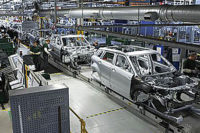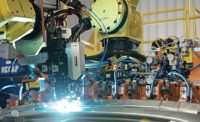Steel is not about to disappear anytime soon as the dominant material used in the home appliance industry. Unlike automakers, which are turning to aluminum, carbon-fiber composites, magnesium, plastic and other lightweight materials, steel still rules in the world of refrigerators, dishwashers and dryers.
It’s difficult for upstart materials to compete with sheet metal on cost, strength and appearance in large parts, such as cabinets, tops and bases.
However, Electrolux, General Electric, LG, Whirlpool and other manufacturers are under constant pressure to control their material costs. That’s why they are eager to use thinner sheet metal wherever possible.
“Appliance manufacturers continue to seek new ways to reduce manufacturing costs while designing and incorporating new features that attract new customers,” says Dale Robinson, business development manager for consumer and industrial products at EWI, the leading North American authority on materials joining and applied technologies. “However, manufacturing cost reductions still rule the day.
“Appliance manufacturers are considering the use of thinner steel, such as high-strength steel,” adds Robinson. “But, the material reductions [must] offset the costs of the more expensive materials per unit weight.”
Manufacturers are using more cold-rolled, fully galvanized, hot-dip galvanized, hot-dip aluminized and organic-coated steel sheet. “These higher-strength steel grades allow engineers to use thinner appliance walls with the same strength,” says Olaf Winter, a spokesperson for ThyssenKrupp AG, a leading steel producer.
“This trend is driven mainly by costs,” claims Winter. “The higher costs of high-strength steels are overcompensated by weight savings and correspondingly lower logistics costs.”
“Thinner materials are being [used throughout the appliance industry],” notes Terry Tripp, strategic account manager and engineering product specialist at Semblex Corp. “Obviously, thinner means lighter. Less material weight [translates into] savings in cost of unit, plus [lower] transportation and freight costs.”
Tripp says he has recently seen sheet thicknesses in the 0 .024 to 0.040 inch range. “However, the industry is trying to find ways to reduce this even more,” he points out. “As this gets thinner, fastening becomes more difficult.
“In fact, in some cases today, we are swimming in uncharted waters as we go thinner,” adds Tripp. “Typical rules-of-thumb for fastening sheet metal then must be reevaluated specific to the manufacturer’s application.”
Fastening Challenges
Appliance engineers have several options for joining sheet metal, including screws, rivets, welding, bonding, clinching and folding. Which is best depends on the material, its thickness and the application requirements. Most engineers rely heavily on mechanical fasteners.
“Traditional threaded fasteners [such as AB sheet metal screws] are still the highest volume by far,” says Tripp. “Some blind fastening is used in nonservice areas. [However], alternative products are becoming more popular. [For example], plastic screw bosses [are being used in place of] traditional clip-style nuts, which are more expensive, heavier and can cause injury during installation.”
According to Tripp, some riveting, clinching and welding is done by appliance manufacturers, but fasteners are the most popular way to join sheets. “[They allow for] serviceabilityand disassembly, [and cause] less damage to cosmetic surfaces,” he explains. “For end-of-life and recycling applications, quick removal of various components [is important].”
As the appliance industry continues to hunt for thinner sheet metal, engineers are faced with new fastening challenges. Fasteners that are effective on older, thicker sheets often don’t work well with thinner materials. Several new products have been developed to address that challenge, such as Fastite 2000 from Research Engineering & Manufacturing Inc. (REMINC) and SHEETtracs from EJOT GmbH & Co.
“Thicker sheets allow for more length of engagement of threads engaged in the material,” notes Tripp. “That results in more shear area, which supports higher strip-out torque values of the sheet and higher pull outs.”
“As material thicknesses decrease, fastening can become more problematic,” warns Tripp. “Thinner materials are more difficult to predict the performance of the fastener on a consistent basis.
“The most common challenge is stripping of the sheet metal prior to reaching safe tightening torque due to poor drive-to-failure ratio, the difference between thread forming torque and strip out,” Tripp points out. “Type AB sheet metal screws have marginal D-F performance that only gets worse as the sheet metal gets thinner.”
“Most sheet metal assemblies are positional situations in appliance applications,” notes Ken Gomes, vice president of engineering and product development at REMINC. “The screw is not required to create a high clamp force. The main function of the screw is to hold the components in place. The least expensive way of doing this is often to use a thread-forming screw in a prepunched hole in both pieces of the sheet metal being assembled.”
The goal when assembling sheet metal is to form an internal thread, tighten the screw without applying too much torque, and avoid stripping the thread. As a screw is tightened, friction under the bearing surface and friction in the thread is what resists stripping the sheet metal.
“In an older [appliance] application, let’s say the sheet metal is 2millimeters thick, made form soft steel,” says Gomes. “This provides a certain level of torque to resist stripping the internal thread in the sheet metal.
“In a newer application, the sheet metal could be a high-strength alloy steel, which is stronger, but much thinner, so the resistance to the applied torque is less,” explains Gomes. “So, there is a greater chance of stripping the sheet metal. When you strip the sheet metal, the screw does not apply enough clamp force to keep the sheet metal components in place. Old assembly tools may not have the control capability to apply such a low level of seating torque to provide reliability for each assembly.”
One way to improve the situation is to use a fastener like the Fastite 2000 screw, which forms threads differently than a standard AB thread forming screw. It uses a small pilot hole that causes the sheet metal to extrude, forming more thread engagement, and more resistance to stripping the sheet metal. Since the Fastite 2000 screw requires more torque to strip the sheet metal, the driver has a larger torque window to use for tightening, resulting in less stripped assemblies.
“Creating a high clamp load is usually not a major concern,” claims Gomes. “In those situations where a high clamp load is important for a sheet metal application, a pierce nut or weld nut is attached to the sheet metal. These nuts are substantially thicker than the sheet metal, providing more resistance to stripping and more capability to apply a high seating torque, creating a high clamp load.
“When assembling sheet metal in an appliance, such as stoves or washing machines, it is not very common to use pierce nuts or weld nuts because of the high cost and because a high clamp load is not required,” says Gomes. “Pierce nuts and weld nuts are [more frequently] used in automotive applications.”
Clinching and Bonding
Clinching is a popular way to join sheet metal without screws, bolts or rivets. It’s used to assemble all types of large appliances, including dishwashers, dryers, ovens, refrigerators and washing machines. “I cannot think of one appliance manufacturer that is not using clinching in its production,” says Bruno Maczynski, marketing manager at Tox Pressotechnik LLC.
“Engineers are looking for joining solutions that eliminate fasteners and the complicated feeding systems required to apply them,” claims Maczynski. “In addition, they [want] joining systems that can be used with prepainted and galvanized sheets. The possibility of eliminating fasteners, feeding systems and paint curing ovens offers substantial savings to appliance manufacturers.”
Clinching is a clean cold-forming process that does not generate heat, sparks or fumes. It doesn’t require cooling systems for electrodes, as is needed in spot welding. In addition, the joining process can be used with dissimilar materials and it can be used with different thickness materials.
“Another advantage of clinching is when it’s used in conjunction with adhesives,” notes Maczynski. “Clinching keeps parts together while the adhesive cures.”
“Manufacturers of appliances want to implement efficient production processes and joining methods that satisfy their customers’ needs,” adds Gudrun Weigel, director of engineering at DELO Industrial Adhesives. “Fast, simple, cost-efficient and, of course, process-reliable are the keywords today. As ever-thinner sheet steel materials are used, conventional joining methods, such as welding, are not possible anymore, as the welding seams become visible at the assembly and impair the design.
“This is where adhesives come into play,” Weigel points out. “Adhesives allow quick, reliable, high-strength joining of a broad variety of material combinations. Processes can be automated very well, are reliable and help achieve very high production speeds, resulting in very profitable production.”
Weigel says stud bonding is an energy-efficient way to join thin sheets. “Weld studs can be found in housings of household appliances, such as washing machines and stoves,” he explains. “However, stud welding reaches its limits where the sheet thickness to be joined is thinner than 0.5 millimeters.
“From this thickness, welding is not longer possible,” claims Weigel. “Furthermore, the spot weld emerging on the opposite of the sheet impairs the appearance, especially when joining components with visible faces.”
DELO and Bollhoff recently developed a new hybrid joining process called ONSERT. “Special connection elements are bonded to a substrate,” explains Weigel. “The adhesive is cured within a few seconds using an LED lamp. The fixing elements are initially molded with a transparent plastic so that the bonding area is accessible to light.
“Bond studs combine the advantages of weld studs, such as a high degree of automation, short cycle times and high loading capacities, with the [ability] to bond sheets with a thickness below 0.5 millimeters and nonmetal, lightweight materials,” adds Weigel. “This joining method is suitable for components that have to give an attractive appearance.”
Web Extra: Innovative Screwdriving Methods Address Sheet Metal Challenges









